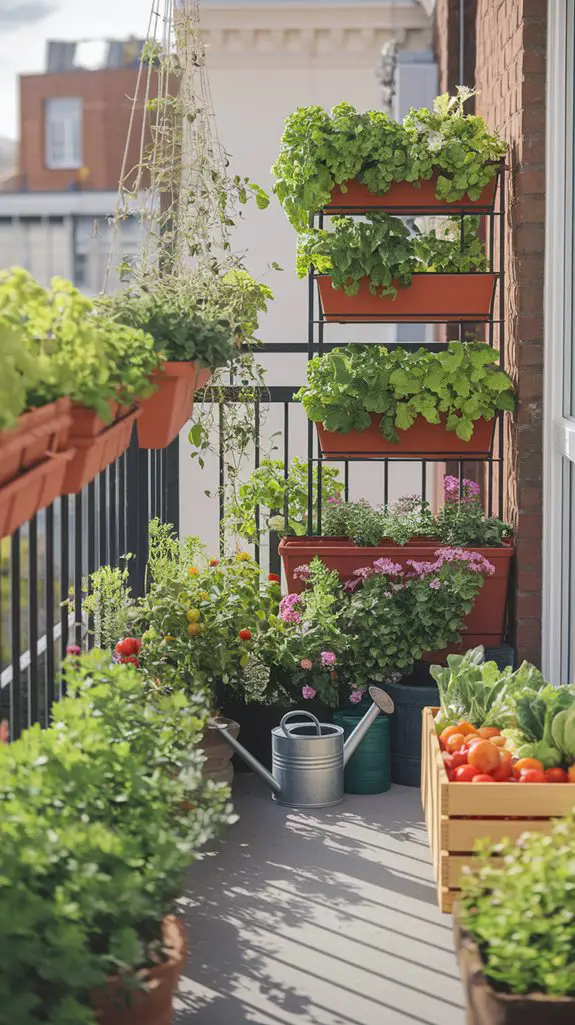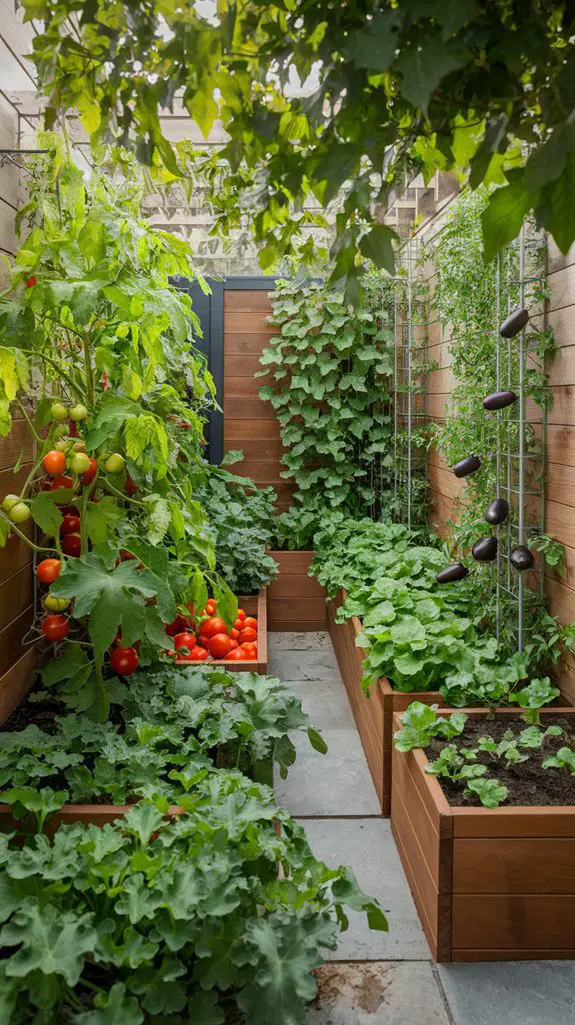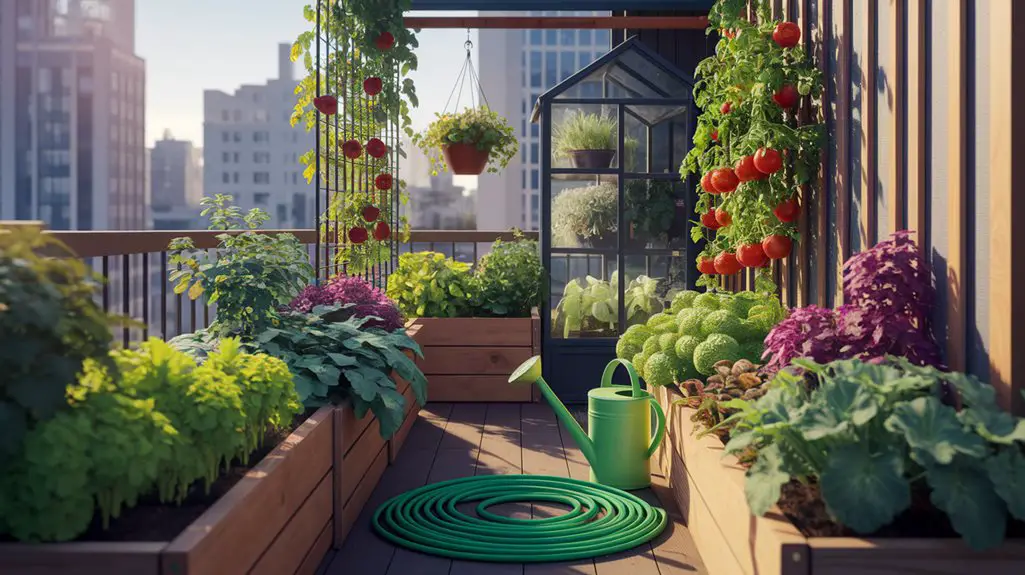A community garden in Brooklyn transformed a 10’x12′ plot into a food source yielding over 200 pounds of produce annually through vertical techniques. You’ll find similar success by thinking three-dimensionally in your limited space. Strategic use of walls, trellises, and stackable containers creates growing areas where none existed before. The difference between a sparse harvest and abundance often isn’t square footage—it’s how effectively you utilize every cubic inch of growing space.
Vertical Gardening Solutions for Limited Ground Space
When ground space becomes a limiting factor in your vegetable gardening endeavors, vertical solutions offer a practical and efficient approach to maximize production. Implement wall-mounted planters, tiered stands, or repurposed pallets to create multi-level growing systems that exploit underutilized vertical space.
Select appropriate climbing vegetables like pole beans, cucumbers, and indeterminate tomatoes, which naturally grow upward with proper support structures. Install trellises, garden netting, or string systems at planting time to avoid root disturbance later. For heavier fruiting plants, incorporate sturdy support mechanisms capable of bearing increased weight as plants mature.
Consider specialized vertical systems such as hydroponic towers or modular stacking planters that integrate irrigation and nutrient delivery. These engineered solutions optimize space utilization while maintaining ideal growing conditions for each plant variety. Additionally, vertical gardening techniques can enhance air circulation and sunlight exposure, which are critical for healthy plant growth.
Container Gardening Essentials for Patios and Balconies

Container gardening represents the ideal approach for urban dwellers with limited outdoor space such as patios and balconies. This method optimizes productivity while allowing complete control over growing conditions.
Your success hinges on these critical elements:
- Container selection – Choose food-safe vessels with 12-18″ depth minimum and adequate drainage holes; 5-gallon containers suit most vegetables.
- Growing medium – Use high-quality potting mix specifically formulated for containers, not garden soil which compacts readily.
- Strategic placement – Position containers to maximize available sunlight (6+ hours daily) while considering weight limitations of your structure.
- Water management – Install drip irrigation systems with timers to maintain consistent moisture levels despite containers’ rapid drying tendency.
Monitor container plants vigilantly as they’re more vulnerable to temperature fluctuations than in-ground counterparts. Additionally, consider using vegetable gardening techniques that enhance growth and yield in small spaces.
High-Yield Vegetable Varieties Perfect for Small Gardens

Selecting the right vegetable varieties constitutes perhaps the most critical decision for space-constrained gardeners seeking maximum productivity. Compact cultivars bred specifically for density and continuous harvesting will optimize your limited footprint.
| Vegetable | Recommended Variety | Yield Per Square Foot |
|---|---|---|
| Tomato | Tiny Tim | 5-7 lbs |
| Cucumber | Spacemaster | 8-10 fruits |
| Lettuce | Salad Bowl | 3-4 heads |
| Spinach | Melody | 2-3 lbs |
| Peppers | Redskin | 15-20 peppers |
Bush varieties outperform vining types in confined settings, eliminating the need for extensive trellising. You’ll achieve particularly impressive yields with determinate tomatoes, compact zucchini, and cut-and-come-again greens that regenerate after harvesting. When selecting varieties, prioritize those labeled “container-friendly” or “compact-growing” to guarantee appropriate scale for your microplot.
Square Foot Gardening Method for Maximum Efficiency
The square foot gardening method transforms space limitations into a strategic advantage for the urban gardener. By dividing your growing area into 1’×1′ squares, you’ll optimize plant density while maintaining appropriate spacing for each crop variety.
To implement this high-efficiency system:
- Construct a 4’×4′ raised bed divided into 16 equal squares using string or thin wood slats.
- Fill with balanced “Mel’s Mix” (⅓ compost, ⅓ vermiculite, ⅓ peat moss) for superior drainage and nutrition.
- Plant according to density guidelines: 1 plant per square for large crops, 4 for medium, 9 for small, 16 for tiny.
- Maintain vertical supports at the north side to prevent shading while expanding growing capacity upward.
This grid-based approach eliminates wasted space, simplifies succession planting, and yields remarkable harvests from minimal square footage. Additionally, using raised garden beds can enhance soil quality and improve drainage, further supporting successful growth.
Succession Planting Strategies to Boost Harvests
While traditional gardening often relies on single-season plantings, succession planting maximizes your small garden’s productivity through strategic timing and placement of crops. This technique involves three primary approaches: same-crop sequencing, intercropping, and relay planting.
Same-crop sequencing requires sowing seeds every 2-3 weeks to guarantee continuous harvests. For example, plant radishes or lettuce in 14-day intervals to extend your harvest window considerably.
Intercropping utilizes different maturation rates—plant fast-growing radishes between slower-developing carrots. When radishes are harvested, carrots have space to mature fully.
Relay planting introduces new crops as others finish. As spring peas decline in summer heat, replace them with heat-loving beans in the same space.
Track your plantings with a calendar to optimize timing and avoid gaps in production. Utilizing succession planting techniques can help ensure that you make the most of your available garden space.
Space-Saving Trellises and Support Structures
Vertical gardening transforms limited horizontal space into productive growing areas through strategic implementation of trellises and support structures.
When selecting vertical solutions for your compact garden, prioritize durability, appropriate height, and compatibility with specific crop requirements.
- A-frame trellises maximize production by supporting climbing plants on both sides while creating a self-supporting structure that requires no wall attachment.
- String trellises using garden twine and bamboo stakes offer lightweight, customizable support for tomatoes, cucumbers, and peas.
- Livestock panel arches create walk-through tunnels that support heavy-fruiting vines while doubling as garden division elements.
- Repurposed materials like old ladders, fence panels, and bed frames provide sturdy structures while reducing costs and environmental impact.
Consider each plant’s growth habit when designing your vertical supports to guarantee ideal light penetration and air circulation. Additionally, implementing vertical gardening techniques can lead to increased yields and healthier plants in confined spaces.
Micro-Greens and Quick-Growing Crops for Tiny Plots
Maximizing harvest frequency within minimal garden footprints becomes possible when you incorporate micro-greens and fast-maturing crops into your cultivation strategy.
These plants require only 1-3 weeks from seed to harvest, allowing multiple growing cycles in a single season. In containers as shallow as 2 inches deep, you’ll achieve impressive yields of nutrient-dense greens.
Focus on varieties like mizuna, arugula, mustard greens, and radish tops, which thrive in succession plantings. Implement a staggered seeding schedule every 7-10 days to maintain continuous production.
For slightly larger spaces, consider quick-maturing vegetables such as bush beans (45-60 days), baby carrots (50 days), and leaf lettuce (30 days). These crops efficiently convert limited square footage into productive growing area while minimizing resource investment and maximizing nutritional return. Additionally, growing in raised garden beds can improve soil quality and drainage, further benefiting plant growth.
Companion Planting to Optimize Small Garden Beds
Companion planting represents a strategic approach to intensify production in constrained growing areas. By deliberately positioning complementary species in proximity, you’ll create beneficial relationships that maximize yield while minimizing square footage requirements.
- Pair nitrogen-fixing legumes (beans, peas) with heavy feeders (tomatoes, corn) to improve soil fertility without additional amendments.
- Implement the “Three Sisters” technique—corn provides structure, beans fix nitrogen, squash suppresses weeds with broad leaves.
- Integrate aromatic herbs like basil and marigolds alongside vegetables to repel pest insects while attracting beneficial pollinators.
- Utilize vertical space by combining climbing species with ground-dwelling crops (trellised cucumbers over lettuce).
This symbiotic methodology optimizes not only spatial efficiency but also enhances plant health, reduces pest pressure, and improves overall ecosystem resilience within your limited garden footprint. Additionally, companion planting techniques can create a more balanced ecosystem, encouraging natural predators to thrive and reducing the need for chemical interventions.
Soil Management Techniques for Intensive Small-Space Growing
When cultivating vegetables in limited areas, soil health becomes the foundational cornerstone of productive intensive gardening.
You’ll need to employ targeted amendments to combat rapid nutrient depletion common in dense plantings. Incorporate compost at 25% volume ratio to improve structure and microbial activity while adding slow-release organic fertilizers to sustain multiple crop cycles.
Implement a strategic rotation of deep and shallow-rooted vegetables to access different soil layers. You should monitor pH levels monthly, adjusting with sulfur or lime as needed for ideal nutrient availability.
Practice no-dig techniques where possible to preserve soil structure and beneficial organisms. Between plantings, integrate cover crops like buckwheat or clover to prevent erosion and fix nitrogen—cutting these plants before seeding to create in-situ green manure. Additionally, consider establishing raised garden beds to enhance soil drainage and accessibility, which can further boost your gardening success.
Water-Efficient Systems for Compact Vegetable Gardens
Water conservation represents a critical component of successful small-space vegetable gardening, as limited growing areas can’t afford wasteful irrigation practices.
Implement precision systems that deliver moisture directly to root zones while minimizing evaporation and runoff.
- Install drip irrigation with adjustable emitters positioned at each plant’s base to provide customized water delivery.
- Incorporate ollas (unglazed clay pots) buried neck-deep that slowly release moisture through porous walls directly to roots.
- Add water-retaining polymers or coconut coir to your growing medium to increase moisture retention capacity.
- Set up rainwater harvesting systems with barrels connected to downspouts for a sustainable water supply. Rainwater harvesting systems can greatly enhance the efficiency of your water usage while promoting a healthy garden ecosystem.
These systems considerably reduce water usage while maintaining ideal soil moisture levels.
You’ll find that targeted hydration promotes healthier root development and reduces disease pressure from excess foliage wetness.
Conclusion
You’ve now verified that space limitations needn’t restrict your growing potential. The integration of vertical systems, container cultivation, and intensive planting techniques truly transforms yield possibilities. By implementing succession planting and companion strategies, you’ll maintain continuous harvests throughout your growing season. Remember, soil quality and water efficiency remain foundational to your success. Apply these evidence-based methods, and you’ll consistently exceed traditional yield expectations from your compact growing space.




